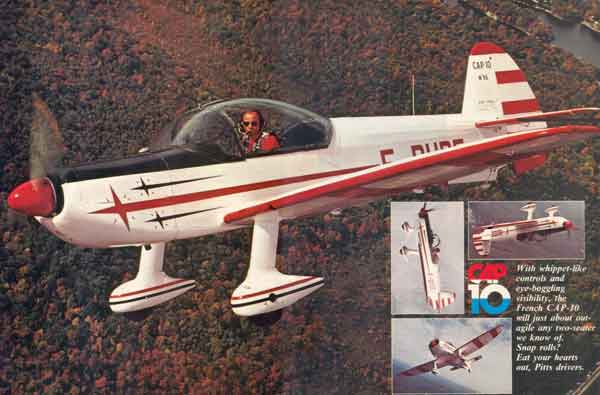
 |
PAGE FOUR The stalls are pretty much what you'd expect; a little on the sharp side with a wing dropping, if the ball isn't centered perfectly. We were falling out at about 50 with full flaps. The inside spins are entirely normal and stop the second you reverse rudder and release back pressure on the stick. In spin recovery we found it was absolutely essential that you keep the ailerons neutralized or they'd start grabbing wind on the recovery and give you kind of a funny jerking motion during the pull out. Inverted spins used a little opposite aileron for recovery and were just as easy to stop. Takeoffs and landings were almost boring, they were so easy. I'd have to stick it somewhere between the Cub and the Citabria as far as required proficiency goes, which is to say it doesn't take much proficiency at all. Visibility around the nose is great and the only area of ground handling
that could cause even the slightest problem was that the rudder is a
tiny bit quick, but certainly no more so than a Cub's. The CAP 10 is
moving a little faster than a Cub so it just seems twitchier. On takeoff
it required a bit of rud- Landings are actually easier than the takeoffs. We were approaching at 120 kmh (approximately 73 mph) and even with full flaps it felt like it was going to glide forever. The flaps steal part of the rudder's effective wind so flaps-down slips are only moderately useful. The gear is pleasantly stiff so rather than getting a bounce if you don't flare quickly enough (which I didn't a couple times), or if you drop it in, what you get is more of a skip than a bounce. That same stiffness makes wheel landings no-sweat affairs. If the airplane needs any one thing modified, it would be the cabin ventilation system. All it has now are vents in the windshield that when opened in cruise all but poke holes in your eardrums. Bubble cockpit airplanes are hot and noisy anyway, so Mudry should do something about furnishing a better and quieter flow of air. To cater to U.S. buyers' tastes, they should also probably go to American instruments, jazz up the paint schemes and throw a little Naugahyde and fake wood around. Neither are necessary, but they might sell more airplanes that way. I came away from my weekend of CAPping with mixed feelings. From an aerobatic standpoint, there was no doubt about it that it is some kind of fantastic airplane and I'd defy anybody to bop along on a cross country in it and not fall in love with it. If I have any reservations it would be that for that kind of money I would want to own something that looks a little more exotic and tear my heart and my mind to shreds everytime I see it. I guess esthetically my tastes are elsewhere. On the other hand, maybe esthetically I don't have any taste at all, because everywhere we parked the airplane, a drooling mob immediately gathered around it. Yep, $30,000 is a lot of money. But remember how many different airplanes
you get for the money; an acrobatic super ship, a docile trainer and
a far-better-than-average cross country mount. Also remember that we're
in an era of $3,000 Volkswagens and 40-cent Cokes, so maybe thirty big
ones isn't that much money. Besides, did you ever try a vertical four-point
in a Volkswagen? BD
|
||||